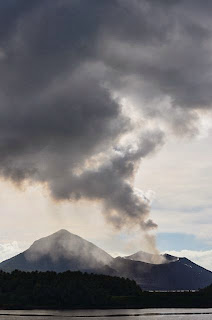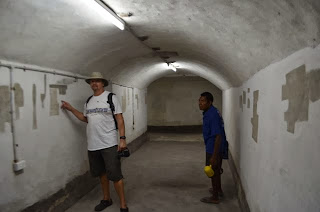Beep, Beep goes the 6:00 am alarm this morning, today was going to be a very full day. As were going to be in port, the ship had a sunrise Remembrance Day service to honour and recognize the Day and the many Veterans on board - very well done as they had the ceremony mid ship under the clear morning sky. I did a bit of bouncing between the service and my station at the front of the ship. When I came on deck at about 6:15, I heard a different yet familiar sound. Different in that it was not the normal sound of the water breaking at the bow but familiar as I quickly knew what the sound was, Dolphins and many of them, time to get the camera flashing. So the day began in this most amazing way. Dolphins, Remembrance Day Ceremony and Scenery, and just incredible scenery on this beautiful sunny and warm morning, yes that is an active Volcano greeting us with a smoke filled billowed hello.
This is our first visit to Papua, New Guinea and what incredible scenic beauty as we sailed past and around the active volcano and into Simpson harbour and past the enigmatic Beehive islands. This is going to be a hot day.
We were docked by the scheduled 8:00 time and off the ship on onto the shuttle to the market by 9:00. The market (daily and for the local people) was colourful, lively and filled with friendly people and the cutest little kids - all with their Betel juice orangey toothed smiles. They loved having their pictures taken and loved even more to see their pictures on the camera. The woman with the knife in her head was great fun.
A quick note on the chewing of these betel nuts, this is a local pastime in New Guinea, and a rather messy ritual. First, you chew the betel nut's fleshy core to a pulp. Then you dip various parts of a mustard plant into a bowl of lime (a white powder made from crushed sea shell that has been baked) and carefully add the
stuff to your mouthful of pulp. When chewed together, this combination should produce a bright red liquid that must be spat out repeatedly, as if one were chewing tobacco. So watch where you step...
We left the market for a stroll in the sauna like heat to the Hotel Rabaul, about a kilometer or so away. A block or so into this stroll we hear "hello tourists" from some Australian. Jan asks if he is a local and he gives us his story of how he was traveling with his yacht some 40 years ago around the world which ended here (he thought it was the most beautiful place he had ever seen), so he stayed. During this time and through many of the storms and volcanic eruptions his yacht became permanently beached, okay by him as he is not going anywhere. Anyway he said that our walk will be long and hot and that we should consider a local bus, he says they are cheap. As we are telling him that we do not have the local currency and that we not familiar with the bus routes. He steps into the street and says it is the number 8 bus, "look here is one now". He stops the empty bus and chats with the driver and minutes later we are on the bus taking us to a couple of view points and then back to the Hotel Rabaul, all for about $20.00 for an hour. So we say thank you to this stranger.
At this point I will note some history of this area from some of our reading to give you some background of this area and why some of these people here have blond (ish) hair.
The first settlers arrived on the main island (the second largest in the world, after Greenland) from Southeast Asia more than 50,000 years ago. European explorers, who spotted the coastline in the 1400s, didn't exploit the island—it was pretty much left alone until the 1800s. But then the Dutch, Germans and British split the island into colonies. Australia (100 mi/160 km south) inherited administration of the British colony, called Papua, and the German colony after World War I. During World War II, the northern half of the island was invaded by Japan, but eventually came under Allied military administration. Papua joined administratively with New Guinea following the war, and the territory was placed under international trusteeship. It regained independence in 1975. (The Dutch half of the island was seized by Indonesia in 1963 and is now the troubled province of Irian Jaya.)
Rabaul was the provincial capital and most important settlement in the province until it was destroyed in 1994 by falling ash from a volcanic eruption. Rabaul volcano's powerful 1994 eruption occurred at the same time as two other volcanoes, Vulcan and Tavurvur, erupted. Within hours of the beginning of the eruption, heavily populated Matupit Island in the center of the caldera sunk beneath the sea. Rain soaked the thick ash that fell on buildings, and the combined wet ash weight collapsed 80% of the buildings in Rabaul. The ash was up to seven feet thick throughout the city. Even today, most of the old city is a moonscape of ash and buildings without roofs.
After the eruption the capital was moved to Kokopo, about 12 miles away. Rabaul is continually threatened by volcanic activity due to being built on the edge of Rabaul caldera, a flooded caldera of a large volcano. Rabaul is slowly rebuilding in the danger zone. During World War II the Japanese captured it in 1942, and it became the main base of Japanese military and naval activity in the South Pacific. Settlements and military installations around the edge of the caldera are often collectively referred to as Rabaul despite the old town of Rabaul itself being reduced to practical insignificance by the volcanic eruption in 1994. As a tourist destination, Rabaul is popular for scuba diving and for snorkeling sites and a spectacular harbor. It had been the premier commercial and travel destination in Papua New Guinea and indeed in the wider South Pacific during much of the 20th century until the 1994 volcanic eruptions. Rabaul Airport was completely destroyed in the 1994 eruption. The airport was in direct path of the falling ash from the nearby vents. The airport was later rebuilt at Tokua, farther away outside the caldera to the southeast, but has occasionally been closed by ashfall from the continuing volcanic activity in the Rabaul caldera. The local currency is the Kina at an exchange rate of about 1.92 to the Dollar.
The People of East New Britain are of Melanesian descent, speaking Austronesian languages of which there are sixteen on the island. "Kuanua", which the Tolai speak, is the main language of the Gazelle Peninsula. The Peninsula is inhabited by five major ethnic groups consisting of Tolai, who dominate the Peninsula, followed by the Baining, Sulka, Taulil and Pomio. The population of East New Britain at the 2000 census was 220,133. The local people ask you please not to give money to the children who will very politely "escort" you around. Give them a cold drink, some coloured pencils or something of that sort instead. The local people are very dignified and do not want their children "begging" from the passengers please respect their wishes. there is a fair amount of local people who speak very good English.
We did give some small change to the 7 year old young man that went through the effort of dressing the part of the traditional aboriginal (I think his mom had something to do with that) - he did look great. Our view points included the Admiral's bunker (Yamamoto) with attached museum and the Japanese War Memorial. We also viewed another incredible bunker on the grounds of the hotel. Jan and I then walked the kilometer back to the ship (Jeff and Joy opted for the stray shuttle that stopped for us) - there were a few sights we were interested in seeing on route plus we needed to walk off a few of the meals that we had been enjoying. Back to the ship for a late lunch barbeque and a great sail away from this very picturesque port.
A couple of pillow card quotes: To travel is to discover that everyone is wrong about other countries. - Aldous Huxley
and
The whole object of travel is not to set foot on foreign land; it is at last to set foot on one's own country as a foreign land. - GK Chesteron.












































No comments:
Post a Comment